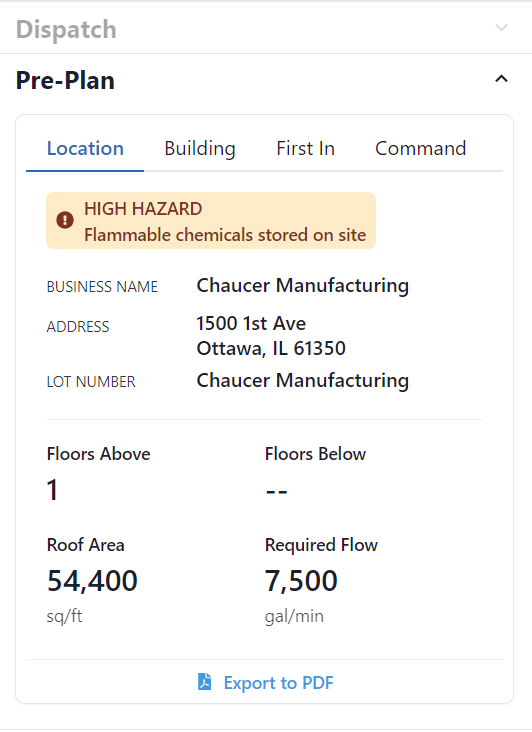By: Joylyn Ortiz
FlowMSP
Artificial intelligence identifies hazards and aids fire operations by helping fire departments flag potentially dangerous buildings in their response area. Using modern technology to scan thousands of buildings, members can quickly pinpoint and mitigate hazards.
Several months ago Mehlville Fire Protection District learned of new technology that scanned their response area using satellite imagery. Artificial intelligence then deemed a building “high hazard” based on two conditions: poor roof condition and high lot debris.
For roof condition artificial intelligence identified roof staining, water damage, holes and other structural issues to flag the roof as “poor” condition. The program was trained to recognize certain common features and match them with new imagery.
Similarly, artificial intelligence identified hazards based on high levels of lot debris. The program recognized obstacles that may impede firefighting measures, such as stacks of pallets, trash, vehicles, swimming pools, and other equipment.
Once Mehlville FPD received the report about high hazard buildings in their response area, they updated their FlowMSP pre-incident planning strategy. It was time for their annual pre-plan review, so they used the new high hazard information to prioritize pre-planning tasks.
First, based upon the satellite imagery that showed severely damaged roofs and high levels of lot debris, the program flagged those locations as “high hazard.” From there members took Mehlville’s 7,000+ pre-plans and selected several hundred high-priority pre-plans to update first.
Next, Mehlville assigned a group of high-priority locations to each engine house, to each officer, instructing them to visit the buildings flagged as high hazards. They needed to verify the hazards that artificial intelligence identified.
Mehlville’s crews then went to the high hazard locations to check the lot and roof conditions. Members compared the actual conditions to the hazards identified by the artificial intelligence program and updated their pre-incident plans accordingly.

Previously Mehlville asked FlowMSP to create the ability to easily note high hazards based upon poor conditions discovered when inspecting a location.
In response, FlowMSP built a High Hazard checkbox and High Hazard Notes field to note hazards on the pre-plan.

Now the high hazard notes appear with the location data for crews to review on calls. Because they know the information will be useful to them, Mehlville FPD’s members do a thorough job noting high hazards on the pre-plans.
Mehlville FPD allows crew members to determine the way they note hazards and obstacles on the pre-plans. Because they will be the ones accessing and using the information, administrators want them to put it in terms that make the most sense to operations personnel.
Mehlville FPD instructs operations personnel to continuously update high hazard information as they discover new hazards. For example, if they run an EMS call and discover a hoarding situation, they immediately open the FlowMSP pre-plan on the mobile app and add high hazard notes.
Updates can apply to residential structures as well as commercial buildings. Any building that contains hazards to firefighters deserves high hazard notes and a pre-incident plan.
Accessing high hazard notes during response is the true value of using artificial intelligence to identify hazards. What good would it do pre-planners to find out about the hazards but not share that information with first responders?
FlowMSP makes the high hazard flag and notes immediately visible with the location data. As a result, when members get toned out to any location, all relevant information automatically pops up for first responders and incident commanders to quickly review.
With the high hazard information in hand, operations personnel make informed decisions. They are more efficient, and the information helps keep members safe.
Mehlville FPD is piloting new uses for artificial intelligence to improve fire operations. Right now they plan to survey the district once a quarter and hope to do it even more frequently. For example, after large storms roll through the area, they want to assess changes in structural damage.
The department recently had a close call when members tried to force entry at a vacant building following heavy rainfall. Unknown roof conditions almost caused personnel to open a door to chest-high gushing water conditions. Thankfully, no one was hurt.
If artificial intelligence had identified the compromised roof before the alarm, members would have known to exercise caution. They could have developed a safer plan to gain entry and address the alarm.
Another future use of AI technology will allow fire departments to look for trends. If a building suddenly has structural damage due to a storm, and in 6 months that damage hasn’t been repaired, then they can visit the location and figure out why.
Similarly, if artificial intelligence identifies trends in roof or lot conditions becoming worse, that information will help departments realize they should follow up, prioritize buildings to inspect, and make sure properties are as safe as possible for operations personnel.
Ultimately, artificial intelligence leads fire departments to possible hazards before they become true hazards. By scanning the response area and finding potentially dangerous buildings, AI narrows the focus and helps members prioritize which buildings to pre-plan first.
As we look to the future of successful fire operations, we will see this technology evolve to become even more accurate and accessible. As a result, fire crews will receive better and better information regarding high hazard buildings, ultimately protecting their lives.
FlowMSP can provide customers with a high hazard analysis to aid pre-plan prioritization. Plus, our high hazard fields and dispatch notifications make building hazard information instantly available to responders. Request a web demo to speak to a member of our team about FlowMSP for your department.
Want to stay informed about new technology from FlowMSP? Subscribe to our email list for weekly updates.